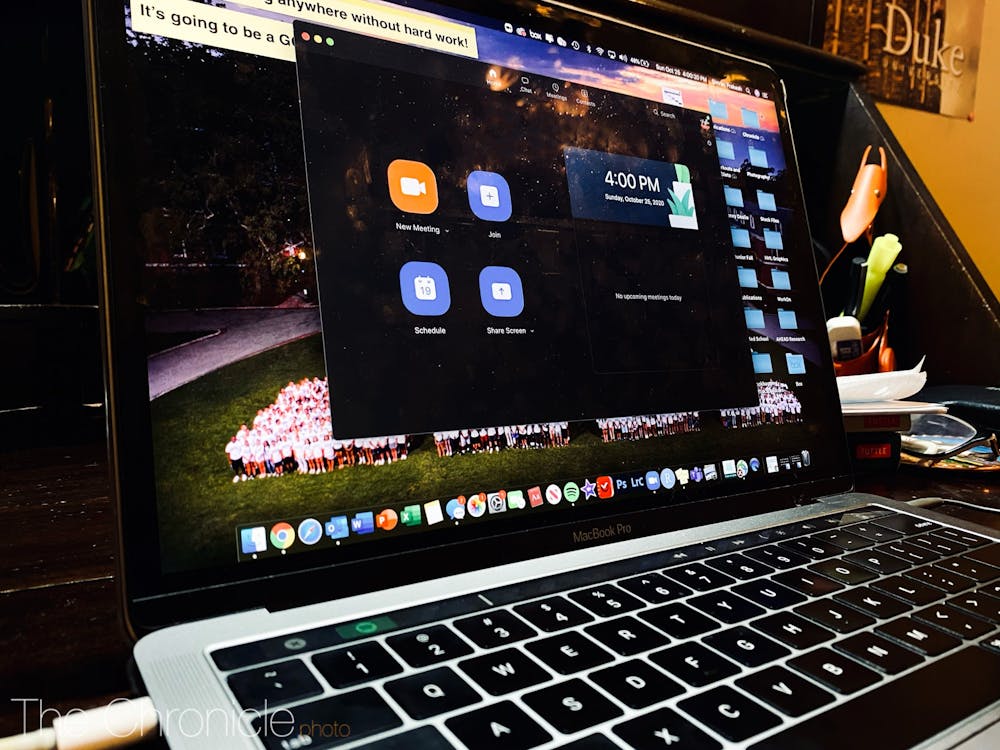Students line Michael Munger’s screen in a four by three matrix. Some look around to grab their pets, unfocused. Others sit quietly, not a question in mind.
Munger, professor and director of undergraduate studies in the department of political science, has no fear of teaching in front of a camera. He fell under thousands of camera lenses when he ran for governor of North Carolina.
What stresses him is the quality of his pandemic-strained teaching.
“It's sort of boring and dry. You've got this Brady Bunch,” Munger said. “It's not that intimate.”
Even when teaching in-person classes, Munger feels distant from his students in 107 Gross Hall, he said. In one class, his 60 students were spread across the room, lined six feet apart, occupying every other row. They were too far away from the board Munger wanted to write on, too far away for Munger to answer questions easily and too far away to engage in discussions with each other.
“The faculty are just not equipped to be able to give the students the sort of experience that we would expect from Duke,” Munger said. “We're letting students down.”
As the pandemic pushes classes out of classrooms and distorts Duke, it affects professors, too, as they must now adapt to new technologies and teach away from their familiar surroundings.
“I have a very active Zoom life, which is nothing I would ever want to brag [about],” said Professor of English Thomas Ferraro. He feels like he’s endlessly in his chair, and said his days are dotted with committee meetings. It’s the three courses he teaches, however, that exhaust him most.
Like Munger, Ferraro feels distant from his students. He said he can’t even physically look at them. Age has hurt his eyesight, he said, so he purchased a larger monitor to better see his students.
He also finds himself needing to listen much harder than before. Despite describing himself as an “awful interruptor,” he hopes that the pandemic has made him a better listener.
Before the pandemic, Ferraro could close his eyes and “get a real feel” for who was paying attention in his classroom, he recalled. He always knew who was whispering in the corner. But he gets none of it on Zoom. His Zoom students might not even see each other, he said.
“We’re not even in the same tic-tac-toe board,” Ferraro said.
He feels an urge to compensate for his discomfort with Zoom and concentrate as much as he can in his 75-minute classes, he said. It wipes him out.
Ferraro believes that well-taught live class is exhilarating. A certain kick came from learning something from his students, excitement enough to run five miles or call an old friend, he said. Even when a class went wrong, whether it be caused by cranky students or sleep deprivation, Ferraro said live classes felt more amenable.
“Going to classes is like baseball. It’s not football,” Ferraro said. “Class doesn't go so hot? Oh, well. There's another one.”
Yet when teaching online, Ferraro said he finds he must quickly and extensively follow-up. He no longer has “the intellectual theater” of a classroom available to him. Student-teacher dynamics involving facial expressions and gestures are lost. As a teacher of novels, Ferraro said he aims to aid his students in seeing the theater in a text or hearing poetry within their ears, yet he finds the voices of his classroom reduced on his computer screen.
“An MP3 file is a terrible thing to do to a song … I'm not doing movies and music online. I need people in a room together watching film or in a room together listening to music and the way it was produced,” Ferraro said.
Although David Banks, professor of the practice of statistical science, believes he does a better job connecting with students when teaching in-person, he still finds that there are some upsides to “Zoom socialization.”
“I’m able to have Zoom meetings with a group of people I went to college with. I get to have Zoom meetings with a group of students I taught back in the 1990s,” Banks said.
Banks recently had a Zoom call with a student he taught in 1992. That year, Banks’ son was about to be born. Banks and his wife were debating between two names, so he put the question to his students on a quiz: “Which is a better name for a child?” He gave the two names as an option and left a write-in blank if students had any alternate suggestions. The student he Zoomed with wrote “Theophrastus Bombastus von Hohenheim,” he recalled.
Impressed that his student knew the real name of the Swiss physician, alchemist, theologian and philosopher Paracelsus, Banks bonded with her. He said that he appreciates that he can continue to maintain connections with students like her through Zoom.
He enjoys having greater control over how his time is spent, too. Before the pandemic, Banks said he was shuffling around his schedule at least once a month to give talks or attend conferences. He said he feels he can now be more productive because he has fewer interruptions.
“By not commuting, I basically have an extra hour in my day, and that’s really good,” Banks said.
For every gain, however, some loss lingers. Munger said he misses how he used to have coffee with students. While he still does once or twice a week at the Broadhead Center, he said it does not feel the same. He and his student sit outside, freezing.
Munger would also chat with students two or three times a day before the pandemic. He could actually connect to his students, learning where they are from and about their families. Despite the lost intimacy, Munger finds a positive in the fact that his office hours are better attended.
“We depend on the energy and dynamism of students to give our lives meaning,” Munger said.
He describes an excitement in meeting new students. Some are goofy and interesting to him, and he enjoys hearing their plans and ideas, regardless of if they work or not. But the pandemic makes him feel isolated.
Ferraro shared a similar sentiment.
“There's no chat around the photocopier, there's no chat in the hallway, there's no chat because you both walked into the gym at the same time, with each other or with me,” he said.
Ferraro believes in the power of tables. To him, tables unite and protect. He recalls teaching in Venice at Ca’Foscari University. Most of the students had never experienced a seminar table, though they were accustomed to lecture halls. To spark conversation among them, Ferraro made them meet him at a cafe instead.
“It's not the coffee or the beer. The only tables they know are social tables,” Ferraro said.
He believes it is the experience of the table that is missing with virtual learning. The social, temporal and corporeal dimensions are gone. Ferraro can no longer go to cafes, host dinner parties or bump into students in the hallways.
Nevertheless, he is hopeful. He said he still feels satisfied when he teaches well, or while reading a terrific paper, regardless of which kind of classroom he is in.
“This, too, shall pass, as my mother says,” Ferraro said. “We will get through it.”
Get The Chronicle straight to your inbox
Signup for our weekly newsletter. Cancel at any time.

Ayra Charania is a Trinity junior and a senior editor of The Chronicle's 118th volume.

